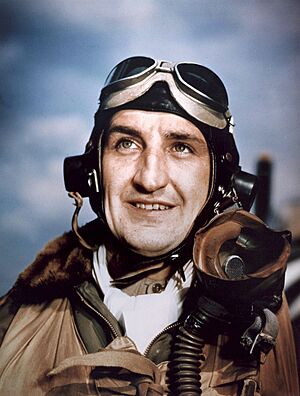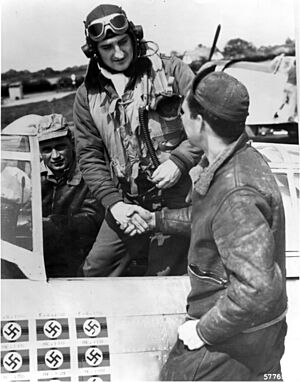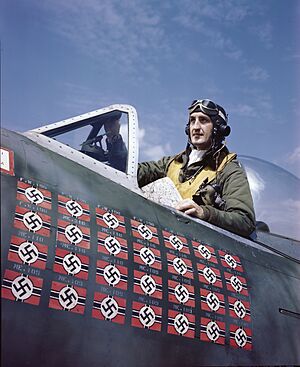Gabby Gabreski facts for kids
Quick facts for kids
Francis Stanley Gabreski
|
|
|---|---|
 |
|
| Nickname(s) | Gabby |
| Born | January 28, 1919 Oil City, Pennsylvania, U.S. |
| Died | January 31, 2002 (aged 83) Huntington, New York, U.S. |
| Buried |
Calverton National Cemetery
|
| Allegiance | United States |
| Service/ |
United States Army Air Corps United States Army Air Forces United States Air Force |
| Years of service | 1940–1967 |
| Rank | Colonel |
| Unit | 15th Pursuit Group No. 315 Polish Fighter Squadron 4th Fighter-Interceptor Group |
| Commands held | 61st Fighter Squadron 55th Fighter Squadron 56th Fighter Group 51st Fighter-Interceptor Wing 354th Tactical Fighter Wing 18th Tactical Fighter Wing 52nd Fighter Wing |
| Battles/wars | World War II Korean War |
| Awards | Distinguished Service Cross Army Distinguished Service Medal Silver Star (2) Legion of Merit Distinguished Flying Cross (13) Bronze Star Medal Air Medal (7) |
| Other work | Grumman Aerospace |
Francis Stanley "Gabby" Gabreski (born Franciszek Stanisław Gabryszewski; January 28, 1919 – January 31, 2002) was a famous American pilot. He was a colonel in the United States Air Force. Gabby flew for 26 years in the military.
He was the top American fighter ace in Europe during World War II. He also became a jet fighter ace in the Korean War. An "ace" is a pilot who shoots down five or more enemy aircraft. Gabby was one of only seven U.S. pilots to become an ace in two wars. He was officially credited with destroying 34½ enemy aircraft in air battles.
Gabreski was also a very skilled leader. He commanded several fighter squadrons and groups. After his Air Force career, he led the Long Island Rail Road.
Early Life and Flying Dreams
Gabby Gabreski's parents came from Frampol, Poland. They moved to Oil City, Pennsylvania, in the early 1900s. His father owned a market, and the whole family helped out.
Gabby's parents wanted him to go to college. He started at the University of Notre Dame in 1938. But he found school very hard at first.
During his first year, Gabby became interested in flying. He took lessons in a small plane called a Taylor Cub. He flew for six hours, but his instructor thought he wasn't a natural pilot. Gabby didn't even fly solo at that time.
World War II Hero
Joining the U.S. Army Air Forces
Gabby decided to join the United States Army Air Corps in his second year of college. He wanted to become a pilot. He started his flight training in East St. Louis, Illinois. He flew planes like the Stearman PT-17.
He wasn't the best student pilot and almost failed. But he kept going! He finished his training in Alabama. In March 1941, Gabby earned his pilot wings. He also became a second lieutenant.
His first job was in Hawaii. He flew Curtiss P-36 Hawk and Curtiss P-40 Warhawk fighter planes. He was there during the Japanese attack on Pearl Harbor. Gabby tried to fight the attackers, but they left before he could reach them.
Gabby learned about Polish pilots who fought bravely in the Battle of Britain. He was Polish himself and spoke the language. So, he offered to work with Polish squadrons to learn from their experience. His idea was approved. He went to England in 1942 and became a captain.
Flying with Polish Pilots
In January 1943, Gabby joined No. 315 (Dęblin) Squadron in England. He flew the fast Supermarine Spitfire Mark IX. On February 3, he faced German Focke-Wulf Fw 190 planes for the first time. He was too excited to shoot any down. He learned an important lesson: stay calm in a fight.
Gabby greatly respected the Polish pilots. He flew 20 missions with them. He learned many valuable lessons about air combat.
Leading the 56th Fighter Group
On February 27, 1943, Gabby joined the 56th Fighter Group. This group flew the powerful Republic P-47 Thunderbolt. He quickly became a flight leader. In May, he was promoted to major.
On June 9, he took command of the 61st Fighter Squadron. Some pilots were not happy about this at first. But Gabby proved himself. On August 24, 1943, he got his first confirmed kill: a German Fw 190.
On November 26, 1943, Gabby shot down two more planes. This made him an "ace" with five kills! He had a very close call on December 11. A German cannon shell hit his P-47 engine but didn't explode. His engine was damaged, but he managed to land safely.
In February 1944, Gabby brought two Polish pilots to his squadron. One was Squadron Leader Boleslaw "Mike" Gladych, who also became an ace. Gabby's number of victories grew steadily. By March 27, he had 18 kills.
In April 1944, Gabby became a lieutenant colonel. He took command of the 61st Fighter Squadron again.
On May 22, Gabby shot down three Fw 190s. On July 5, 1944, he became America's top ace in Europe. He had 28 confirmed kills. No other U.S. pilot fighting the German Air Force (Luftwaffe) surpassed this number.
Becoming a Prisoner of War
By July 20, 1944, Gabby had flown 300 hours in combat. He was supposed to go home. But he decided to fly "just one more" mission. He was escorting bombers over Germany.
On the way back, he saw German planes parked on an airfield. He flew down to attack them. During his second pass, his plane's propeller hit the runway. The engine was badly damaged. Gabby had to crash-land his P-47.
He ran into the woods and hid for five days. But he was eventually captured. He became a prisoner of war (POW) at Stalag Luft I.
Gabby flew 166 combat missions in World War II. He was officially credited with 28 aircraft destroyed in air combat. He also destroyed 3 planes on the ground.
U.S. Air Force Career
After being released from the POW camp, Gabby returned to the United States. He married Kay Cochran on June 11, 1945. He then worked as a test pilot. In April 1946, he left the military for a short time. He worked for Douglas Aircraft.
But in April 1947, he was called back to active duty. He commanded the 55th Fighter Squadron. The Air Force then sent him to Columbia University. He studied Political Science and Russian. He graduated in 1949.
He immediately returned to flying. He became commander of his old unit, the 56th Fighter Group. They were now flying F-80 Shooting Star jets. He was promoted to colonel on March 11, 1950.
Korean War Combat
Gabby fought in the Korean War as well. In June 1951, he went to South Korea with other pilots. They flew North American F-86 Sabre jets. These planes joined the 4th Fighter-Interceptor Group.
On July 8, 1951, Gabby shot down a MiG-15 jet. He shot down two more MiGs in September and October.
Leading the 51st Fighter-Interceptor Wing
The American forces needed more Sabre jets to fight the MiGs. So, the 51st Fighter-Interceptor Wing switched from F-80s to F-86s. Gabby took command of this wing on November 6, 1951.
He was a very aggressive commander. He created a strong rivalry between his wing and the 4th Fighter-Interceptor Wing. This helped them destroy many MiGs. Gabby himself shot down 3½ more MiGs. This made him a jet ace!
Gabby was known for being very focused on getting kills. Some pilots said he didn't always pay enough attention to his wingmen. But others praised him as a great leader and pilot.
One story shows his character. In February 1952, Gabby and Major William T. Whisner were flying. Both had four MiG kills. Gabby damaged a MiG-15, which flew into China. Gabby claimed it as a "probable kill." Whisner chased the MiG and finished it off. He confirmed the kill for Gabby. But Gabby insisted that Whisner claim his part of the kill too. As a result, Whisner became the first pilot in their wing to reach jet ace status.
Gabby's tour in Korea was supposed to end in June. But he kept flying missions to stay in command. However, he was eventually grounded in May.
When he returned to the U.S., he received a hero's welcome in San Francisco. Gabby's 6½ MiG-15 kills in Korea made him one of only seven U.S. pilots to become an ace in two wars. He flew a total of 289 combat missions in his career. His assigned F-86 jet was nicknamed "Gabby."
After Korea
Gabby continued his Air Force career for another 15 years. He commanded three different wings. He retired on November 1, 1967. He had flown over 5,000 hours, with 4,000 of those in jets.
Military Awards
Gabby Gabreski received many awards for his bravery and service:
| Command pilot badge | |
| Distinguished Service Cross | |
| Distinguished Service Medal | |
| Silver Star with bronze oak leaf cluster | |
| Legion of Merit | |
| Distinguished Flying Cross with two silver and two bronze oak leaf clusters | |
| Bronze Star Medal | |
| Air Medal with silver and bronze oak leaf clusters | |
| Air Force Presidential Unit Citation with bronze oak leaf cluster | |
| Air Force Outstanding Unit Award | |
| Prisoner of War Medal | |
| American Defense Service Medal with one service star | |
| American Campaign Medal | |
| Asiatic-Pacific Campaign Medal with bronze campaign star | |
| European-African-Middle Eastern Campaign Medal with two bronze campaign stars | |
| World War II Victory Medal | |
| Army of Occupation Medal | |
| National Defense Service Medal with one service star | |
| Korean Service Medal with two bronze campaign stars | |
| Air Force Longevity Service Award with silver oak leaf cluster | |
| Distinguished Flying Cross (United Kingdom) | |
| Chevalier of the Legion of Honour (France) | |
| Croix de Guerre with Palm (France) | |
| Croix de Guerre with Palm (Belgium) | |
| Polish Cross of Valour (Polish: Krzyż Walecznych) (Poland) | |
| Republic of Korea Presidential Unit Citation | |
| United Nations Service Medal for Korea | |
| Korean War Service Medal |
Later Life and Legacy
After retiring from the Air Force, Gabby worked for Grumman Aerospace. In 1978, the Governor of New York asked him to lead the Long Island Rail Road. This was a busy train line that needed a lot of help.
Gabby tried hard to make things better. But after two and a half years, he resigned. He felt that others were making it hard for him to improve the service.
Gabby and his wife, Kay, had nine children. Two of their sons became Air Force pilots. His daughter-in-law, Terry L. Gabreski, became a lieutenant general in the Air Force. This was the highest rank for a woman in the USAF until her retirement.
Kay Gabreski passed away in 1993 in a car accident. Gabby died on January 31, 2002, from a heart attack. He was buried with full military honors. F-15E Strike Eagle jets flew in a special "missing man formation" at his funeral.
Gabby Gabreski's legacy lives on. In 1991, Suffolk County Air Force Base in New York was renamed Francis S. Gabreski Airport in his honor. He was also added to the National Aviation Hall of Fame in 1978. A road at Shaw Air Force Base in South Carolina is named after him.
Images for kids
See Also
- Richard Bong, another famous Army Air Forces fighter pilot
- Joseph Foss, a Marine Corps fighter pilot
- David McCampbell, a Navy fighter pilot







